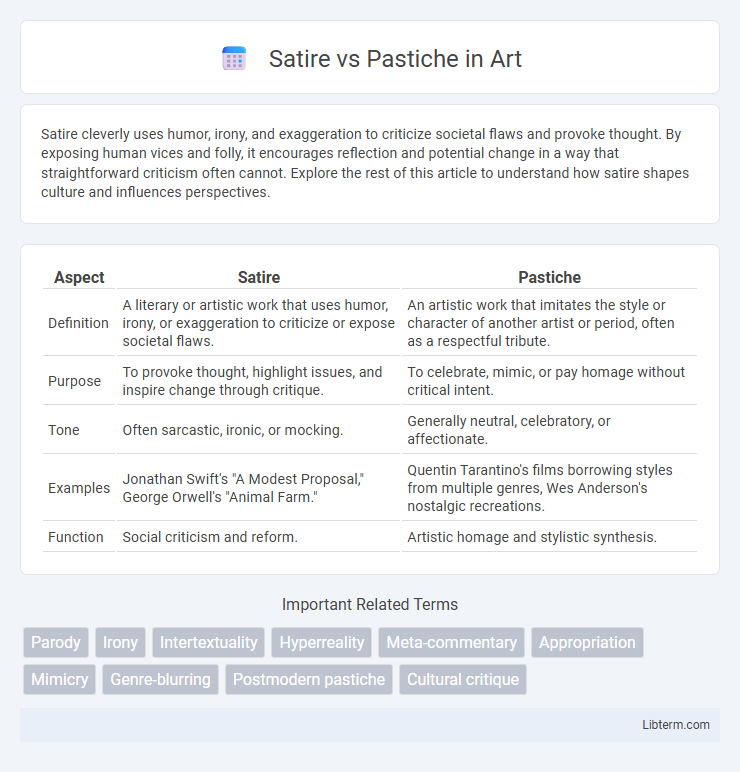Satire cleverly uses humor, irony, and exaggeration to criticize societal flaws and provoke thought. By exposing human vices and folly, it encourages reflection and potential change in a way that straightforward criticism often cannot. Explore the rest of this article to understand how satire shapes culture and influences perspectives.
Table of Comparison
| Aspect | Satire | Pastiche |
|---|---|---|
| Definition | A literary or artistic work that uses humor, irony, or exaggeration to criticize or expose societal flaws. | An artistic work that imitates the style or character of another artist or period, often as a respectful tribute. |
| Purpose | To provoke thought, highlight issues, and inspire change through critique. | To celebrate, mimic, or pay homage without critical intent. |
| Tone | Often sarcastic, ironic, or mocking. | Generally neutral, celebratory, or affectionate. |
| Examples | Jonathan Swift's "A Modest Proposal," George Orwell's "Animal Farm." | Quentin Tarantino's films borrowing styles from multiple genres, Wes Anderson's nostalgic recreations. |
| Function | Social criticism and reform. | Artistic homage and stylistic synthesis. |
Understanding Satire: Definition and Purpose
Satire is a literary and artistic technique that uses humor, irony, exaggeration, or ridicule to expose and criticize human vices, social follies, or political corruption. Its primary purpose is to provoke thought, promote awareness, and inspire change by highlighting the absurdities within society or individuals. Unlike pastiche, which imitates styles to celebrate or pay homage, satire aims to challenge and reform through its critical lens.
What is Pastiche? Key Characteristics
Pastiche is a literary or artistic work that imitates the style or character of the work of one or more other artists, celebrating rather than mocking the original. Key characteristics include the deliberate mixing of styles, genres, or themes, often paying homage to the original sources without satirical intent. It differs from satire by emphasizing imitation and reverence rather than critique or ridicule.
Historical Roots: Satire Through the Ages
Satire has ancient origins dating back to classical civilizations such as Greece and Rome, where playwrights like Aristophanes and Horace used humor and irony to critique politics and society. Throughout the Renaissance and Enlightenment, satire evolved into a sophisticated literary tool employed by figures like Jonathan Swift and Voltaire to challenge authority and provoke social reform. This tradition contrasts with pastiche, which primarily imitates stylistic elements of other works without necessarily engaging in social or political commentary.
The Evolution of Pastiche in Art and Literature
Pastiche in art and literature has evolved from mere imitation to a complex form of homage that celebrates and reinterprets established styles and genres, distinguishing itself from satire's critical and ironic tone. Influential figures like Jorge Luis Borges and contemporary artists have used pastiche to explore intertextuality and cultural memory, enriching narrative depth without the subversive intent typical of satire. The development of pastiche reflects broader postmodern tendencies, emphasizing playful past referencing and the blending of high and low culture to challenge traditional notions of originality and authorship.
Comparing Techniques: Satirical Tools vs. Pastiche Methods
Satire employs irony, exaggeration, and parody as primary techniques to critique societal flaws and provoke thought through humor and ridicule. Pastiche relies on mimicry, imitation, and the blending of multiple styles or genres to celebrate or pay homage without the overt critical intent found in satire. While satirical tools aim to expose and challenge, pastiche methods often emphasize stylistic reconstruction and cultural commentary without direct confrontation.
Intent and Impact: Mockery or Homage?
Satire employs humor, irony, or exaggeration with the intent to criticize or expose flaws, often targeting societal norms, politics, or human vices, thus creating a mocking or corrective impact. Pastiche imitates the style or character of other works primarily as a form of homage, celebrating or paying tribute without the underlying critical intent found in satire. Understanding the distinction clarifies how satire provokes reflection or change through mockery, while pastiche fosters appreciation through respectful imitation.
Notable Examples of Satire in Popular Culture
Notable examples of satire in popular culture include television series like "The Simpsons," which critiques societal norms and politics through humor and exaggeration. Films such as "Dr. Strangelove" use satirical elements to expose the absurdity of nuclear warfare and Cold War paranoia. Literary works like George Orwell's "Animal Farm" employ allegory and satire to comment on totalitarian regimes and political corruption.
Famous Instances of Pastiche in Modern Media
Famous instances of pastiche in modern media include Quentin Tarantino's "Kill Bill," which blends elements from martial arts films, spaghetti Westerns, and Japanese cinema to create a stylized homage. Wes Anderson's "The Grand Budapest Hotel" employs pastiche by integrating visual and narrative styles reminiscent of 1930s European cinema, creating a whimsical yet nostalgic atmosphere. The TV show "Stranger Things" is another notable example, combining 1980s pop culture, sci-fi, and horror tropes to evoke a specific era while crafting an original story.
Audience Reception: Interpreting Satire vs. Pastiche
Audience reception of satire often involves critical engagement, as viewers decode irony and social commentary embedded within the work. In contrast, pastiche typically invites appreciation for homage or stylistic mimicry without necessarily prompting critique or reflection. The effectiveness of satire depends on audiences recognizing underlying messages, whereas pastiche appeals through familiarity and celebration of genre conventions.
Satire vs. Pastiche: The Blurred Lines in Contemporary Works
Satire and pastiche often blur in contemporary works, as both utilize imitation to convey meaning but serve distinct purposes--satire critiques through humor and irony, while pastiche celebrates by homage and stylistic mimicry. Modern creators blend these techniques, resulting in layered narratives that challenge audiences to discern underlying commentary from mere replication. This fusion reflects evolving artistic strategies in postmodern literature and visual media, highlighting cultural critique alongside reverence.
Satire Infographic

 libterm.com
libterm.com